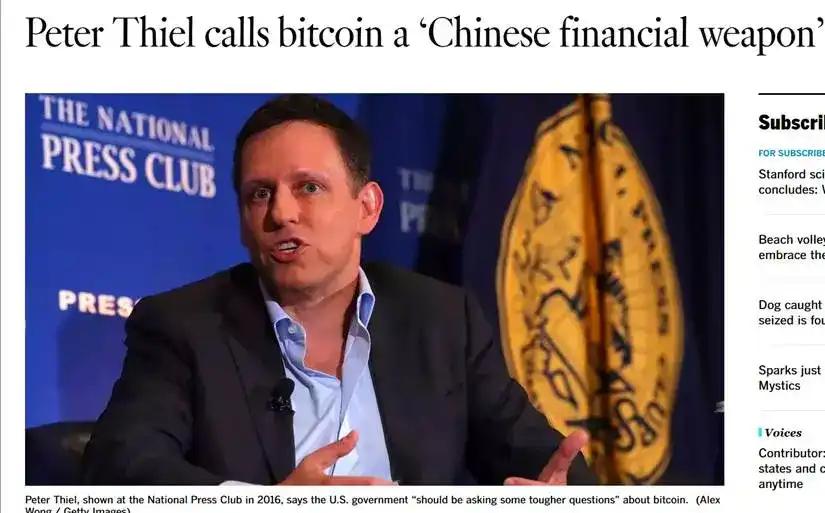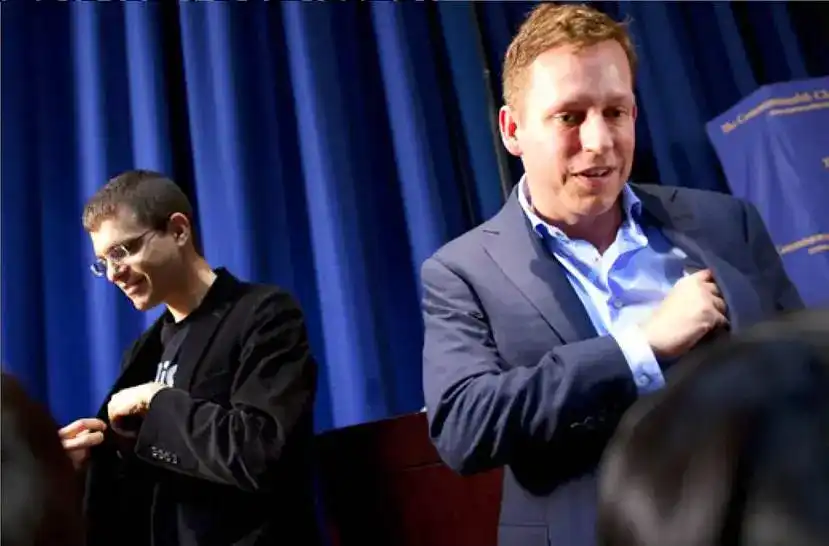Original Title: "BitMine Stock Price Soars: Silicon Valley Venture Capitalist Peter Thiel Bets Big on Ethereum"
Original Author: Zz, ChainCatcher
In July 2025, an SEC filing ignited the crypto community: an entity under Peter Thiel quietly acquired 9.1% of BitMine Immersion Technologies, becoming the largest investor in this Ethereum treasury. Upon the news, BitMine's stock price skyrocketed, reaching a peak of 29.3% during trading.
The X platform exploded: the PayPal mafia godfather finally took action on Ethereum, has Peter Thiel shifted from Bitcoin? Is he looking to replicate MicroStrategy's strategy?
The market's excitement is not without reason. Just a year ago, Peter Thiel was publicly questioning Bitcoin: "We already have ETFs, I don't know who else will buy." With institutional armies already in the game, who can drive the next wave? From Bitcoin to heavily investing in Ethereum, what game is this Silicon Valley billionaire playing?
The Ambition Behind Holding $1 Billion in ETH
BitMine's ambition is clear: to become the Ethereum version of MicroStrategy. On July 14, 2025, BitMine held $500 million worth of Ethereum (163,142 ETH). Three days later, this number doubled to $1 billion, totaling 300,657 ETH. Even in the crypto world, this accumulation speed is considered insane.
But what Peter Thiel is eyeing goes far beyond just another corporate treasury. In 2023, a move by Founders Fund revealed his investment landscape: investing $200 million to purchase Bitcoin and Ethereum, each accounting for half. This allocation itself is a signal that Ethereum has reached parity with Bitcoin.
In addition to the heavy punch of BitMine, Peter Thiel's layout in the Ethereum ecosystem has already quietly begun:
Trading Infrastructure: In 2021, he invested in Bullish Exchange, serving as a senior advisor.
Compliance Infrastructure: In 2024, he invested in Paxos (a regulated stablecoin issuer), and in 2025, he continued to increase his stake by participating in Ubyx, aiming to become the Visa of the stablecoin sector.
DeFi Infrastructure: In June 2025, he led an investment in Avantis, focusing on on-chain derivatives.
Layer-2 Scaling: He invested in Caldera. When mainnet gas fees are high, Layer-2 is key to making DeFi truly usable.
Bitcoin is digital gold, while Ethereum is the new financial market. An investor close to Founders Fund revealed that for value storage, buying Bitcoin is sufficient. But to control future financial infrastructure, you need Ethereum.
This judgment is well-founded. While Bitcoin is still entangled in the debate of store of value vs. payment, Ethereum has already become: the main battlefield for DeFi (with locked value exceeding $100 billion), the preferred platform for stablecoins (USDT and USDC primarily circulate on Ethereum), and the foundational layer for RWA (real-world asset) tokenization.
More critically, Ethereum can generate yield. This is something Bitcoin cannot do. BitMine's Ethereum treasury strategy precisely targets this, allowing assets to generate cash flow.
Peter Thiel's ambition does not stop there: Bullish Exchange secretly submitted an IPO (June 2025), supported the creation of Erebor Bank, which specifically serves crypto enterprises (planning to hold stablecoins), and gained industry influence through CoinDesk. The picture is clear: he is no longer satisfied with merely holding assets but aims to control the channels of asset flow.
The proportion of Ethereum ecosystem investments in Founders Fund's blockchain portfolio is also gradually increasing. If 2014-2022 was Peter Thiel's Bitcoin era, focusing on value storage and ideological narratives, then after 2023, he officially entered the Ethereum era, building practical financial infrastructure.
Bitcoin won the ideological war, but Ethereum will win practical applications. When central bank digital currencies, corporate stablecoins, and tokenized securities become a reality, they will all operate on Ethereum.
Peter Thiel diversifies his holdings in BitMine through various entities, not just investing but preparing for control. If BitMine becomes the largest corporate holder of Ethereum, Peter Thiel will effectively become the shadow central bank of the Ethereum ecosystem. From PayPal to Bitcoin, and now to Ethereum, Peter Thiel's dream of a financial empire has never changed; only the tools have evolved.
Founders Fund Started Accumulating Bitcoin When It Was $1,000
When Bitcoin was still hovering around $1,000, Founders Fund had already begun accumulating. According to insiders, the initial investment reached tens of millions of dollars, which was considered aggressive among institutional investors at the time.
But Peter Thiel's ambition goes beyond that. In 2013, he invested in Block.one (which later developed EOS). Although EOS ultimately failed to shake Ethereum, this investment revealed his true intention: he was not after Bitcoin itself, but the next Bitcoin.
Even more intriguing is his path of layout:
Mining Side: Investing in BitMine in 2025 is just the latest move. As early as 2018, he participated in Layer1 financing.
Trading Side: Before Bullish, he was an early investor in Kraken. Compared to Coinbase's compliance route, Kraken maintained a more cypherpunk style, which is very Peter Thiel.
Infrastructure: In 2021, when everyone was chasing DeFi tokens, Founders Fund quietly invested in Voltage, providing infrastructure for the Bitcoin Lightning Network.
Peter Thiel's understanding of Bitcoin goes far beyond just digital gold. In April 2021, he expressed a viewpoint in a conversation with former Secretary of State Mike Pompeo: Bitcoin could be a financial weapon used by China to undermine the dollar.

The crypto community was in an uproar. Supporters called him a traitor, while opponents labeled him a conspiracy theorist. However, placing this statement within Peter Thiel's overall ideological framework clarifies the logic: Bitcoin is not just an investment; it is also a geopolitical tool that can take the initiative in a new financial war.
Interestingly, just a year later, he changed his tune at a Bitcoin conference, describing it as a revolutionary weapon against financial gerontocracy. He even listed his enemies: Buffett, Larry Fink of BlackRock, and Jamie Dimon of JPMorgan Chase.
In front of conservatives, he spoke of national security. In front of the crypto community, he spoke of a freedom revolution. What remains unchanged is the core goal: to promote a new order independent of the traditional financial system. This precisely showcases Peter Thiel's core trait: using narrative as a weapon.
The results are significant: he timely liquidated before the crypto winter of 2022, making a profit of $1.8 billion; in 2023, when Bitcoin fell to $30,000, he again took action, buying $100 million. A textbook example of high selling and low buying.
A noteworthy detail: in July 2024, when Bitcoin ETFs were launched and institutional funds flooded in, Peter Thiel publicly expressed uncertainty about significant price increases from that point. The real weapon is never an ETF that everyone can buy.
The Unfinished Monetary Dream Behind All Layouts
Looking at Founders Fund's investment portfolio, a clear pattern emerges: they almost never invest in DApps, rarely touch GameFi, and only sample NFTs. What they are truly interested in are: Layer2 scaling solutions (Caldera), compliance infrastructure (Paxos), derivatives protocols (Avantis), and stablecoin networks (Ubyx). Protocols are superior to products; this is Peter Thiel's creed.
Back to 1998, when 23-year-old Peter Thiel and Max Levchin founded PayPal, what was their initial vision? It was not to create a payment tool but to create a new form of currency.

Long before Bitcoin was born, Peter Thiel was already contemplating how to disrupt the monetary system. PayPal even developed a PalmPilot application that could transmit digital cash via infrared. Ultimately, due to regulatory pressure, they had to transform into a traditional payment company.
In 2002, eBay acquired PayPal for $1.5 billion. After cashing out, Peter Thiel's first move was to establish Clarium Capital, systematically searching for the next monetary revolution opportunity. He waited for 12 years.
In 2014, when Peter Thiel first seriously studied Bitcoin, he saw not electronic cash but the unfinished dream of PayPal. "We live in a world where bits are unregulated and atoms are regulated," Peter Thiel summarized in 2015. The subtext is: in the digital world, you can build anything, including an entirely new financial system.
In "From Zero to One," Peter Thiel repeatedly emphasizes: competition is a game for losers; monopoly is what brings excess profits. PayPal's experience taught him that establishing a financial monopoly in the traditional world is nearly impossible. Regulation will stifle you, and big banks will encircle you. Cryptocurrency changed the rules of the game.
How to establish a monopoly in a decentralized world? The answer is: control the underlying infrastructure. When everyone is building on Ethereum, owning Ethereum is equivalent to collecting rent. When all transactions require stablecoins, controlling stablecoin protocols is equivalent to printing money. When regulation eventually arrives, owning a compliance license is equivalent to holding the ticket to entry.
Peter Thiel even funded key figures in this revolution. In 2014, his Peter Thiel Fellowship awarded $100,000 to 19-year-old Vitalik Buterin, enabling him to decide to drop out of the University of Waterloo and develop Ethereum full-time. In a sense, Peter Thiel not only invested in the infrastructure but also in the people building the infrastructure.
This explains why Peter Thiel is simultaneously laying out plans for Erebor Bank (traditional license) and DeFi protocols (decentralized finance); no matter which path the future takes, he is a winner. The deeper reason may be that, in his view, cryptocurrency is not PayPal 2.0, but rather what PayPal should have become: a truly free global financial system, unregulated by any government.
Now, Peter Thiel's Crypto Empire Has Taken Shape
In 2025, Peter Thiel is no longer satisfied with being a passive holder of assets. Through BitMine, Bullish, and Erebor, he is building a complete crypto financial empire.
At this point, a question arises: why is Peter Thiel so aggressive while traditional financial giants are still on the sidelines? Perhaps the answer lies in his statement from 2015: "We live in a world where bits are unregulated and atoms are regulated."
For Peter Thiel, cryptocurrency is not just a financial revolution; it is the ultimate tool for constructing an unregulated world of bits. Now is the time to place bets.
After all, as his friend, Tesla CEO Elon Musk, said: the best adventure is a calculated risk. In this ultimate adventure of cryptocurrency, Peter Thiel's calculations have only just begun.
免责声明:本文章仅代表作者个人观点,不代表本平台的立场和观点。本文章仅供信息分享,不构成对任何人的任何投资建议。用户与作者之间的任何争议,与本平台无关。如网页中刊载的文章或图片涉及侵权,请提供相关的权利证明和身份证明发送邮件到support@aicoin.com,本平台相关工作人员将会进行核查。




